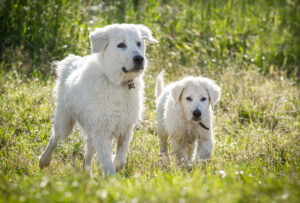If you’ve owned a dog or two for a while, you know that vomiting is not uncommon among canines. But the sight of yellow vomit or bile does not leave any dog owner indifferent. Anyone seeing the yellow stuff will spontaneously wonder: “Why is my dog throwing up yellow vomit?”
Dogs throw up yellow vomit if they have an empty stomach for long hours, have consumed too much fatty food or eaten too much grass due to food allergies and intolerance, if they have abdominal blockages, or for medical reasons such as stomach ulcers, bloat, pancreatitis, or stomach cancers.
This article will explain the causes of yellow vomit among dogs. And because a dog owner’s primary worry is how to help their vomiting dog, we will start by telling you what to give your pet to stop vomiting and to settle your dog’s stomach after throwing up bile.
What Can I Give My Dog For Throwing Up Bile?
Vomiting causes strong contractions in a dog’s abdominal muscles, which makes your dog distressed. Moreover, the loss of body fluids can easily cause dehydration and even turn fatal if severe and prolonged.
As such, the best thing to do is attend to your dog immediately to stop the vomiting and preempt dehydration or any serious aftermaths.
Here are a couple of ways you can stop a dog from puking while taking care of your pet at home.
Give An OTC Anti-Vomit Med
Even though your dog could be vomiting for serious causes, most of the time, a dog that is throwing up bile has an empty stomach, indigestion, or the passing flu.
OTC anti-vomit meds can help your dog to stop throwing up and soothe the upset stomach.
Pepto-Bismol (Bismuth Subsalicylate) is one of the most common anti-vomit OTC drugs for dogs. It is considered safe and is also recommended by the American Kennel Club (AKC).
A single or double dose of one teaspoon per day is recommended. Note that the drug also comes in chews and caplets.
Nonetheless, the drug is associated with gastric bleeding and black stool that can conceal gastric bleeding.
For this reason, it is paramount to consult with your vet before administering Pepto-Bismol to your dog, especially if it’s the first time your furry friend is taking it.
Reglan (Metoclopramide) is also used as an extra label for the prevention of esophageal reflux in dogs.

Give Ice Chips
The most obvious thing to do when a dog is vomiting is to stop sending any food to its upset stomach. However, that does not apply to water, as your dog needs to stay hydrated.
But, for most dogs, drinking water is not always a welcome move for an upset stomach. Ice chips are a good alternative.
There are two reasons ice chips are a good option for a vomiting dog.
- Having your dog lick ice chips will send small amounts of water at a time into your dog’s system and help preempt both vomiting and dehydration.
- Licking on ice chips will cool your dog’s stomach and make your pup feel better, which could work to stop vomiting bile.
While home remedies are a good first move when your dog is throwing up bile, a dog with continuous vomiting or vomiting that comes with other symptoms like fever and seizures should be taken to the vet immediately.
What Will The Vet Do For A Vomiting Dog?
Take your dog to a vet for vomiting anytime your dog throws up bile over a prolonged time period and has any of the following accompanying symptoms:
- Blood spots in the stools or vomit
- Continuous vomiting
- Unproductive continuous retching
- Signs of pain, discomfort, lethargy, or depression
- Dehydration
- Fever
- Seizures
You should also consider bringing the dog to a vet if you have given medicine and your dog still continues to throw up.
Once at the vet, the dog doctor is going to attend to your furry friend by doing the following:
Tracing Your Dog’s Medical History
The vet will do this by asking questions on:
- Your dog’s diet and feeding plan.
- What your dog has fed on in the past 48 hours.
- If any recent changes were made to your dog’s diet.
- If your dog has been exposed to medications or any cleaning detergents and pesticides.
- If your dog has had previous episodes of throwing up bile, the cause and any treatments given may play a part.
- If your dog is on any medications, vitamins, or supplements.
- If your dog has other health issues.

Perform A Thorough Physical Examination
The vet will examine your dog for signs of abdominal pain, bloating, gastritis, dehydration, increased heart rate, and fever, among others.
Depending on the severity of symptoms, the vet may order these tests:
- Complete blood cell count to detect infection and dehydration.
- Abdominal X-ray or ultrasound to check for any abdominal obstructions.
- Electrolyte test to detect any imbalances in electrolyte count.
- Other supporting tests like urinalysis.
Prescribe Treatment
Depending on the diagnosis, the vet may prescribe a gastrointestinal diet (bland diet), anti-nausea medication, intravenous fluids for dehydration, or surgery to remove an abdominal obstruction.
How Do You Settle A Dog’s Stomach After Vomiting?
A dog that is throwing up bile has an upset stomach that needs to be soothed. This can be done through a remedial diet, safe home remedies, probiotics, and additional care.
Remedial Diet
There are three approaches to a remedial diet for a dog that is throwing up bile:
- Giving small amounts of food frequently to a dog that has thrown up bile once due to an empty stomach.
- Fasting your dog for 12 hours if it’s a puppy and 24 hours for a grown dog to allow the stomach lining to heal.
- Giving a bland diet of white rice without salt for a day or two (around 2 tablespoons every 3 or 4 hours for a puppy and a cup every 3 to 4 hours for a grown dog). You could also consider chicken broth and serve it every few hours in small quantities.
Avoid any foods that can upset your pet’s stomach further, including scrambled eggs. Even though eggs are safe and a good source of protein when cooked without additives, AKC suggests that eggs should only be given when your dog does not have any signs of digestive discomfort.
Safe Home Remedies
Home remedies that give your dog’s stomach a soothing effect can be given with the consent of your pet’s vet. Here are a few options in addition to the ginger and coconut milk mentioned earlier.
- Coconut water – has electrolytes to counter dehydration (1 to 3 teaspoons every 2 hours, depending on the age of your dog).
- Peppermint oil – helps calm the stomach lining and stop vomiting (1 to 3 drops once a day).
- Chamomile – repairs the stomach lining and prevents acid and bile reflux (1 to 2 teaspoons for puppies and 3 to 4 teaspoons for adult dogs 2 to 3 times a day).
- Ginger – It is a carminative and helps break up and expel intestinal gas, hence soothing the stomach (half a cup of coconut milk with a tablespoon of freshly grated ginger is left to simmer for 10 minutes, and then 1 to 3 teaspoons given every hour or two).

Probiotics
Probiotics, like Greek yogurt, will restore the good bacteria in your dog’s stomach and help repair the stomach lining faster.
Additional Care
You can soothe a dog’s upset stomach using other additional care practices like gently rubbing the stomach (not pressing), giving ice chips if your dog can’t drink water, and keeping your pet indoors where it is cool.
Should I Feed My Dog After Vomiting Yellow Bile?
Whether you should feed your dog or not after vomiting yellow bile will depend on your dog’s situation.
When To Feed Your Dog After Vomiting?
If your dog has vomited bile once due to an empty stomach and has no signs of being sick, you can feed the dog small amounts of food every few hours. It is, however, wise to wait for at least 6 hours to allow your dog’s stomach lining to settle down.
A bland diet of white unseasoned rice or chicken broth given in small quantities a few times during the day is the best choice, as explained in the previous section. This will prevent your dog’s upset stomach from getting worse.
Water should not be withheld from a vomiting dog, as throwing up causes dehydration. If your dog can’t hold the water in its stomach, substitute it with ice chips, as these will soothe your pet’s stomach, and most dogs will like them.
When To Fast Your Dog For A Longer Period After Vomiting?
If your dog’s vomiting is consistent, you should consider withholding food for longer (12 to 24 hours).
Once vomiting stops, do not rush to give food until around 6 hours after the last episode of throwing up bile. A bland diet should be given gradually.
The Diet-Change Alternative
Experts advise that a change of diet is a great way to help a dog that has been vomiting bile.
First, consider giving your dog a light night meal or a treat before bed if throwing up bile seems to appear first thing in the morning.
Further, since indigestion, food allergies, and food aversions are common causes of throwing up bile among dogs, a readily palatable and digestible food can change the situation.
We recommend Pet Plate. This human-grade meal has a choice of turkey, chicken, and beef taste and is made to make even the pickiest pups eat without any fuss.
Your dog’s stomach will benefit from the freshness of the Pet Plate’s high-protein and grain-free meal.
You can also help your dog’s digestion with treats that have probiotic properties. The Multivitamin Treats Supplement – Zesty Paws Probiotics are an optimal choice. These treats have six probiotics for your pup’s digestion, bowel, and immune support.
Why Is My Dog Throwing Up Yellow Vomit?
Vomiting in dogs can be considered normal or abnormal depending on several factors, which should also determine whether you should be concerned about your dog throwing up.
Normal And Abnormal Vomiting In Dogs
If your dog has sporadic episodes of vomiting in a year, then that is considered normal and should not be cause for alarm.
But frequent unexplained vomiting in dogs should be considered abnormal and should be diagnosed and treated by a vet. And if the frequent vomiting has your dog throwing up bile, all the more reason to seek vet care.
Why Do Dogs Throw up Yellow Vomit?
Generally, dogs may vomit to resolve an upset stomach due to indigestion, a passing virus, the ingestion of something that their stomach does not agree with, or as an indication of an underlying medical issue.
When your dog throws up yellow vomit, one or more of the following is usually the cause.
- An empty stomach: Yellow vomit consists of stomach acids and bile. If your dog has an empty stomach, the acids irritate the lining of the stomach and cause vomiting. That’s why your dog may throw up bile after waking up in the morning or when hungry.
- Food allergies and intolerance: If a food does not agree with your dog, it can cause inflammation (gastritis). Feeding kibble to your dog can also dry up your dog’s digestive tract, causing it to expand and produce acid and bile reflux.
- Bilious vomiting syndrome: A condition where bile leaks from the small intestines into the stomach. It is caused by hunger, consuming too much fatty food, drinking too much water, or eating too much grass.
- Intestinal blockages: These can be caused by ingesting toys, bones, or other hard-to-digest objects.
- Medical conditions: Including ulcers, bloat, pancreatitis, parasite infections, inflammatory disease, and stomach cancers.
Related Questions
What Does Parvo Vomit Look Like? Parvo vomit has a mucous or foamy look and can be clear, yellow, greenish, or have a coffee-brown color. Dogs with canine Parvovirus lose their appetite, have abdominal pain and bloating, and have an empty stomach because they can’t keep anything down, which is why they consistently throw up bile.
Can A Dog Pass A Stomach Virus To A Human? Yes, a dog can pass a stomach virus to humans. A study in 2015 revealed that Norovirus is one of the viral zoonotic infections that can be transmitted from dogs to humans. The Department of Health & Human Services of Victoria in Australia also reports that viral gastroenteritis can be passed from dogs to humans.
How Do I Know If My Dogs Stomach Hurts? You can tell that your dog’s stomach hurts if he is drooling, gulping, licking the air or lips, has a noisy stomach, is restless, is guarding the belly, or has vomiting and diarrhea. Other signs of a hurting stomach in dogs include lethargy, burping, passing gas, loss of appetite, shaking, reduced activity, and change in interactions.





